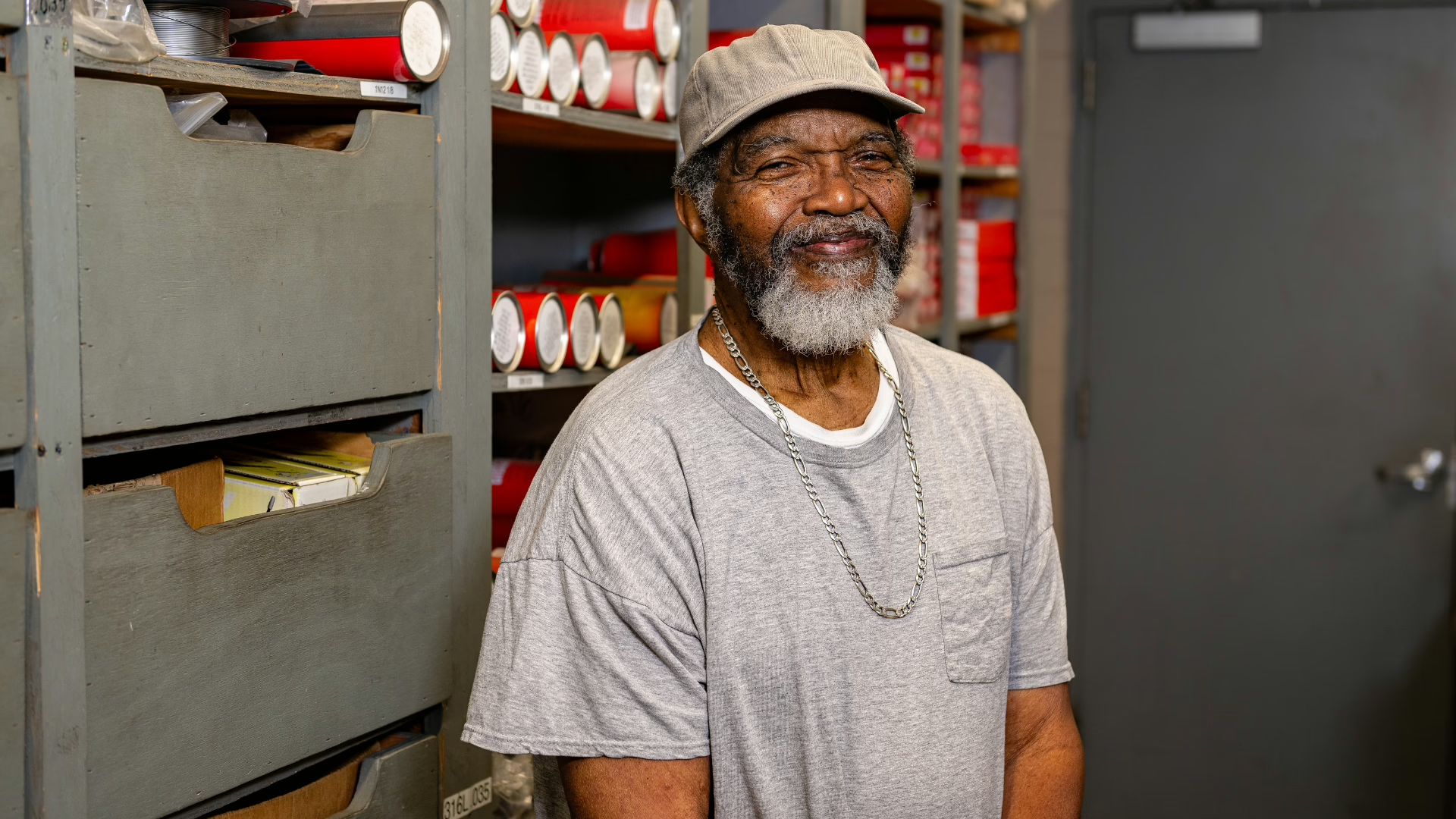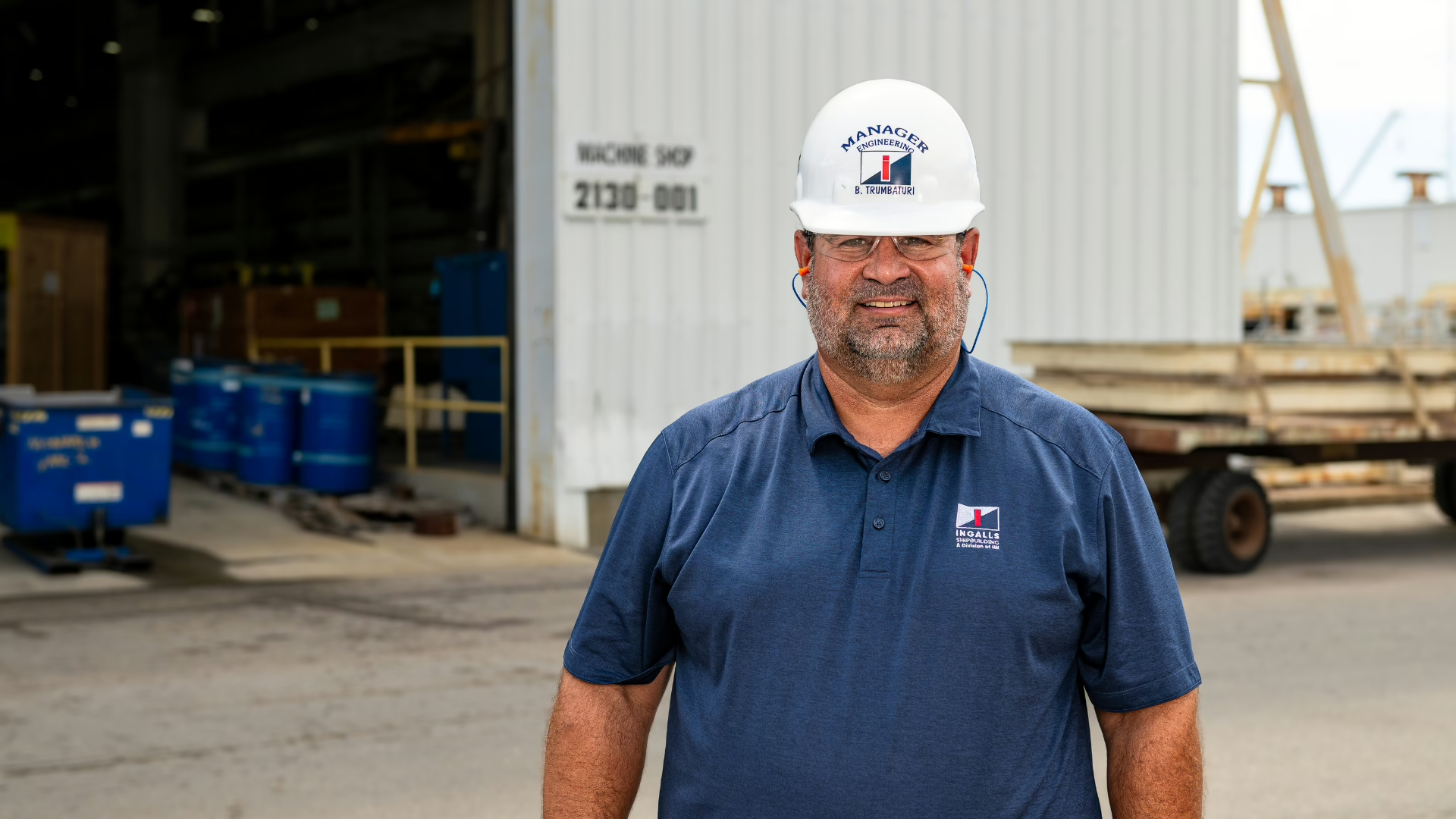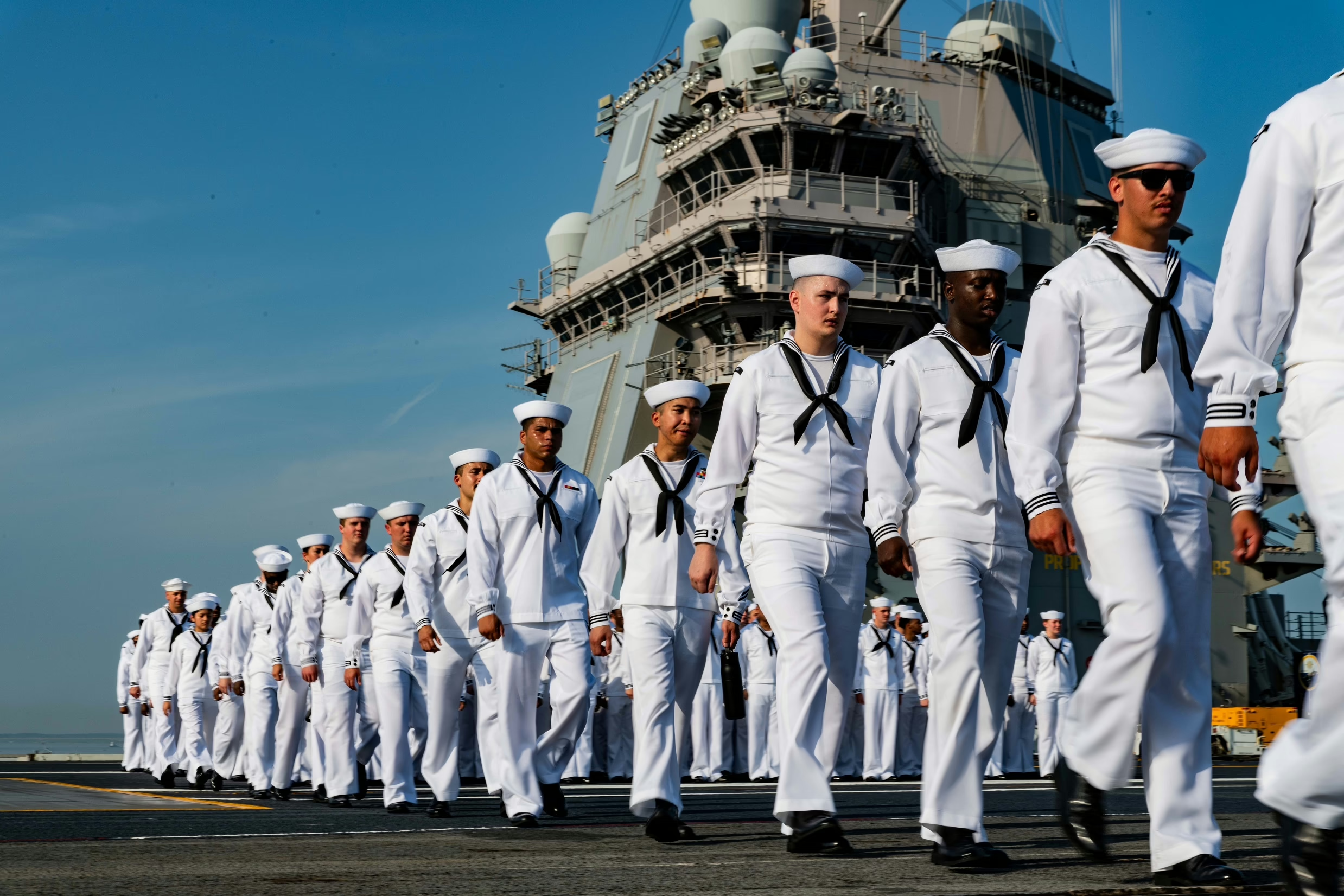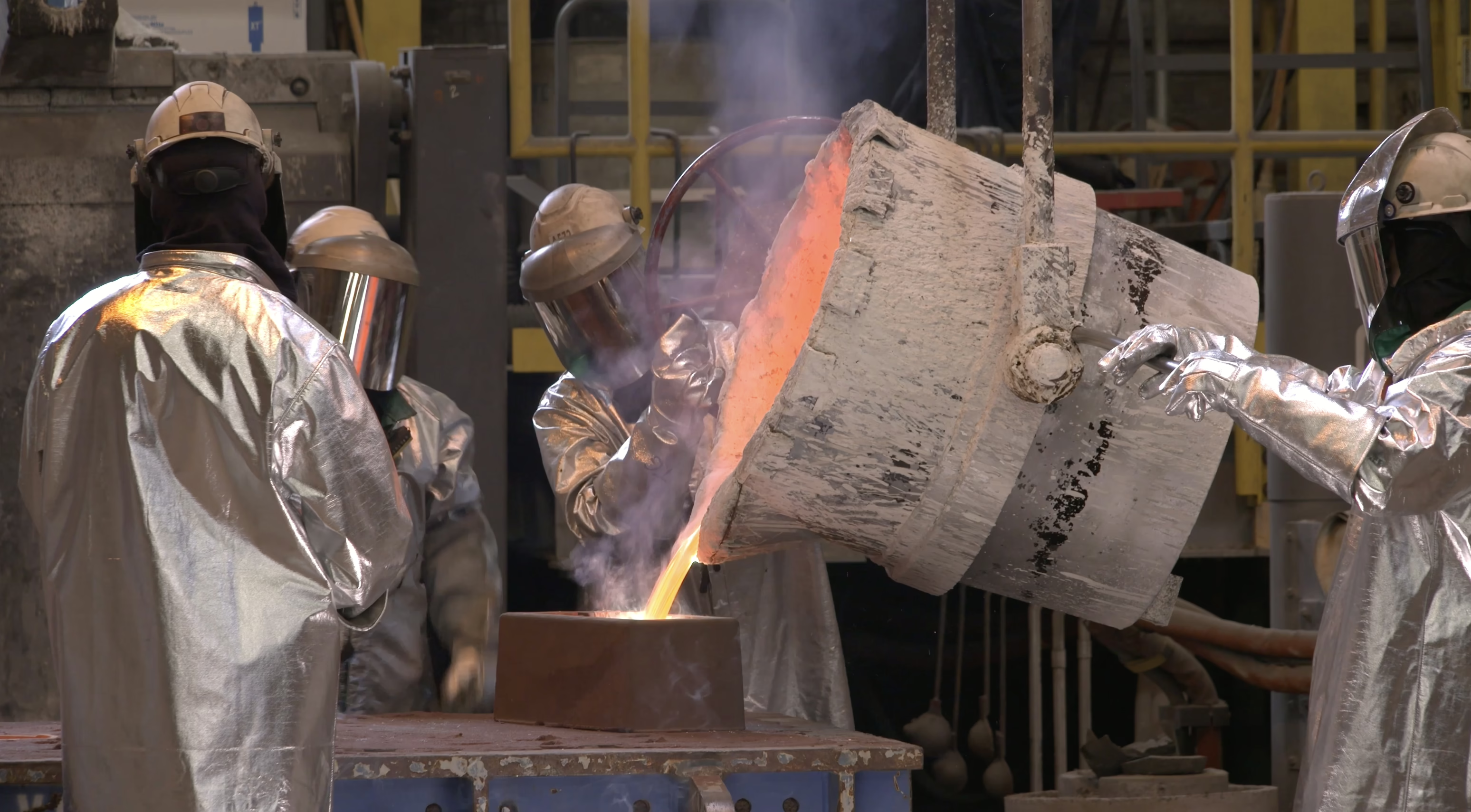Photo caption: DIEGO GARCIA, British Indian Ocean Territory (May 16, 2025) Sailors assigned to the Arleigh Burke-class guided-missile destroyer USS Ralph Johnson (DDG 114) stand in ranks on the fo’c’sle during a sea-and-anchor evolution while pulling into U.S. Navy Support Facility (NSF) Diego Garcia, DDG 114 was built at HII’s Ingalls Shipbuilding division and delivered to the U.S. Navy in 2016. (U.S. Navy photo by Mass Communication Specialist 1st Class Hannah Fry)
May 30, 2025
HII’s Weekly News Digest is compiled every Friday by the Corporate Communications team to summarize and highlight news stories of significance to the company.
Reconciliation Bill Moves $4.5 Billion For Virginia-Class Purchase In 2026: USNI News reported on Friday, May 23, that the House-approved version of the reconciliation bill shifts $4.5 billion to buy a Virginia-class submarine in fiscal year 2026 instead of FY 2027. The move is designed to ensure the Navy will acquire two Virginia-class submarines in FY 2026 by using money in the reconciliation legislation to buy one of the boats. The unique four-year spending horizon of the reconciliation bill leaves those crafting the legislation to make educated guesses on what the Navy might ask to buy over the next four budget cycles. Without a formal presidential budget submission, the House and the Senate are relying on less formal methods to craft the $150 billion in overall defense spending. The shift in the bill comes as the Navy and submarine contractor General Dynamics Electric Boat and HII’s Newport News Shipbuilding division negotiate the next 15 nuclear submarines — a planned multi-year deal for 10 Block VI Virginia-class and five Build II Columbia-class ballistic missile submarines. The Senate is set to take up the reconciliation bill next. The Hill reported on Wednesday GOP senators are vowing to rewrite the bill, but they’re still weeks away from putting together a package that can muster the 51 votes it needs to pass. Those negotiations could last into July.
Nippon-US Steel Deal To Advance: The Wall Street Journal reported on Friday, May 23, that Nippon Steel received a conditional green light from President Donald Trump to take control of U.S. Steel under what the president has described as a partnership. Key aspects of the deal still need to be ironed out. But Trump’s announcement signals the Tokyo-based company could eventually enter the American steel market and make the big investments in U.S. Steel. Both Nippon and U.S. Steel are seeking more guidance from the administration about how much ownership Nippon could ultimately gain in this partnership. Reuters reported on Tuesday that the U.S. government will have veto power over key decisions relating to U.S. Steel as part of a deal with Nippon Steel, utilizing what is known as a golden share. The details will be laid out in a national security agreement the companies will sign with the U.S. government, U.S. Sen. David McCormick said. The Washington Post reported on May 23 that U.S. Steel’s headquarters will remain in Pittsburgh, Pennsylvania. While details of the deal are still being finalized, the president is expected to hold a rally on Friday in Pittsburgh to tout the deal as a victory for his tariffs and American workers, Bloomberg reported on Thursday.
European Shipyards Must Consolidate To Win: Defense News reported on Monday that French Navy Chief of Staff Adm. Nicolas Vaujour is suggesting that European shipyards must consolidate to a handful of players that can win export contracts. Europe lacks a single naval strategy and few overlapping defense plans. A joint venture formed in 2020 between Italy’s Fincantieri and France’s Naval Group, known as Naviris, aimed to serve the French and Italian navies, as well as pursue export opportunities outside Europe and be a leader in shipbuilding consolidation. While Naviris won part of a $1.7 billion contract to upgrade the French-Italian Horizon-class frigates in 2023, success in the latter two areas has been more elusive. “In an ideal world, we would have three or four (shipyards) that challenge each other, but would above all be winning export market share abroad,” Vaujour said. Meanwhile, the Financial Times reported on Monday that Pierroberto Folgiero, the chief executive of Europe’s largest shipbuilder, Fincantieri, has called on European countries to scale up their underwater defense capabilities amid rising threats and shifting U.S. foreign policy. The Italian state-controlled shipbuilder announced last week that it expects its underwater division, which focuses on submarines, communication systems and autonomous vehicles, to double in size over the next two years.
| Social Media Highlight Of The Week
Posted Thursday on HII’s LinkedIn page:
“ What we create is powerful. Who creates it is extraordinary. In 2010, Lanetta Fantroy, test engineer, was a single mother of four, part of a family with a deep tradition in shipbuilding. Fast forward 15 years, not only did she follow in her family’s footsteps, two of her children now work at Ingalls Shipbuilding, a Division of HII, and another one serves in the US Navy on an Ingalls-built ship. Finding a greater sense of purpose in her role of delivering a quality ship for our nation and being a generational shipbuilder, Lanetta helps to ensure operating systems aboard all vessels are world-class. Thanks for what you do, Lanetta!” |
Hanwha Wants To Partner With Canada To Sell Submarines: BusinessKorea reported on Tuesday that Hanwha Group is expanding its North American interests to Canada where it is showcasing the KSS-III Batch-II submarine as an offering for the Canadian Patrol Submarine Project. USNI News previously reported that the Canadian government is requesting proposals from foreign defense contractors to determine how much it can afford to expand the size of its aging conventionally-powered submarine fleet. Hanwha Ocean also plans to establish an in-service support center in Canada to provide ongoing maintenance and upgrades for over 30 years. Yonhap News Agency reported on Friday, May 23, that — if an agreement with the Canadian government can be reached in 2026 — Hanwha would aim to deliver the first batch of submarines by 2032 and the remainder by 2035. Hanwha’s push into Canada’s defense market comes less than a year after it bought the Philly Shipyard, in Pennsylvania, where it plans to spend $70 million to upgrade a pair of former Navy dry docks at the shipyard.
CNO Position Remains Unfilled As Concerns Grow: Breaking Defense reported that the Navy has been without a Senate-confirmed chief of naval operations for more than 90 days, marking the longest vacancy in the service’s history. Analysts and former officials warn the absence is delaying key decisions on force design, budgeting and modernization. Acting CNO Adm. James Kilby is filling the role temporarily, but experts say acting leaders are often hesitant to make major strategic calls. The leadership gap comes as the Trump administration pushes rapid changes across the Pentagon, including a defense budget realignment. Politico previously reported Adm. Daryl Caudle is a leading candidate for the job, though no official nomination has been made. Lawmakers say the Navy risks falling behind during a critical period for modernization and global readiness without a CNO leading the way.
HII’s Weekly News Digest is produced by HII’s Corporate Communications team and posted to Homeport every Friday.
Please note: Social media is blocked on HII computers for most employees. Employees are encouraged to visit HII’s Facebook page and other social media sites on personal time and from non-work devices.
Send feedback to: HII_Communications@hii-co.com.













